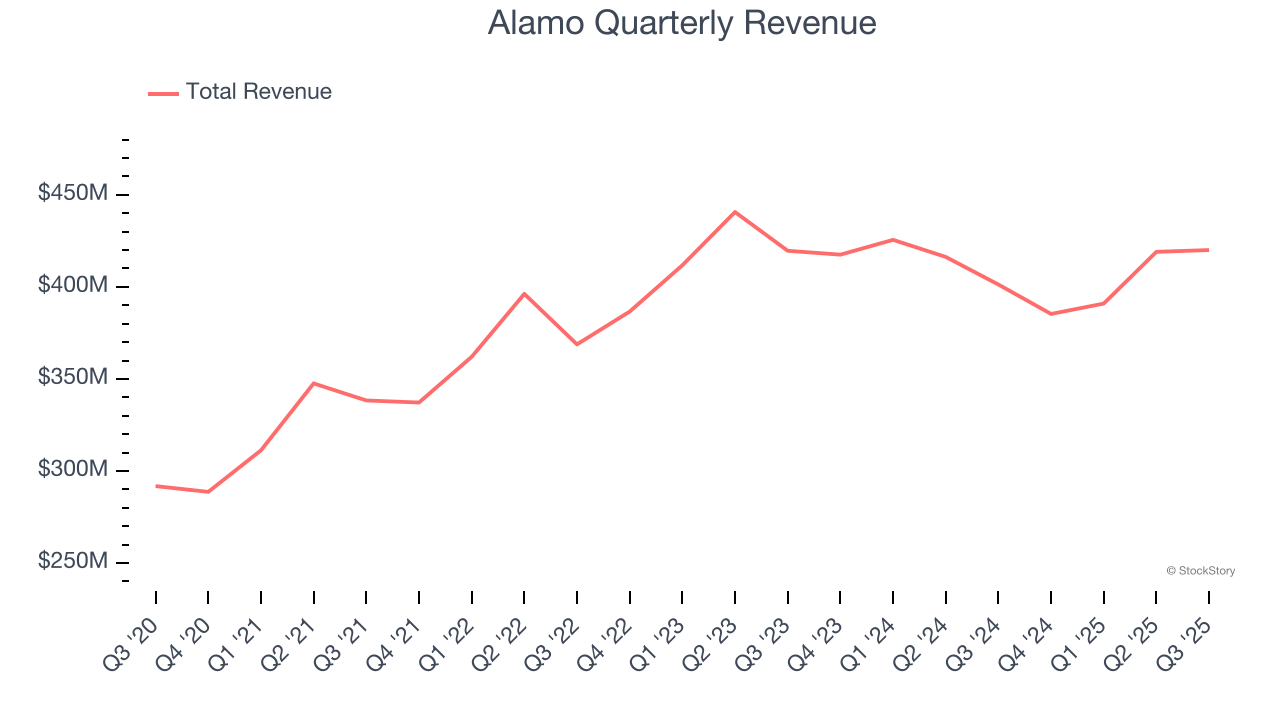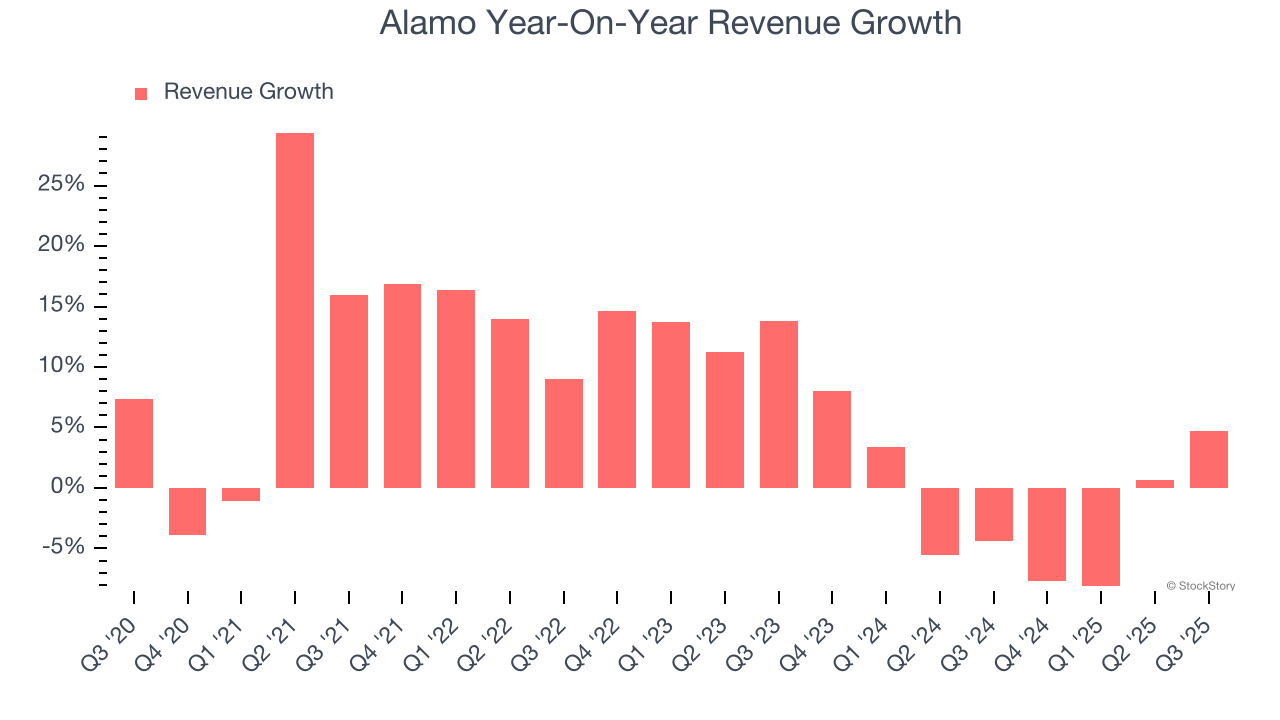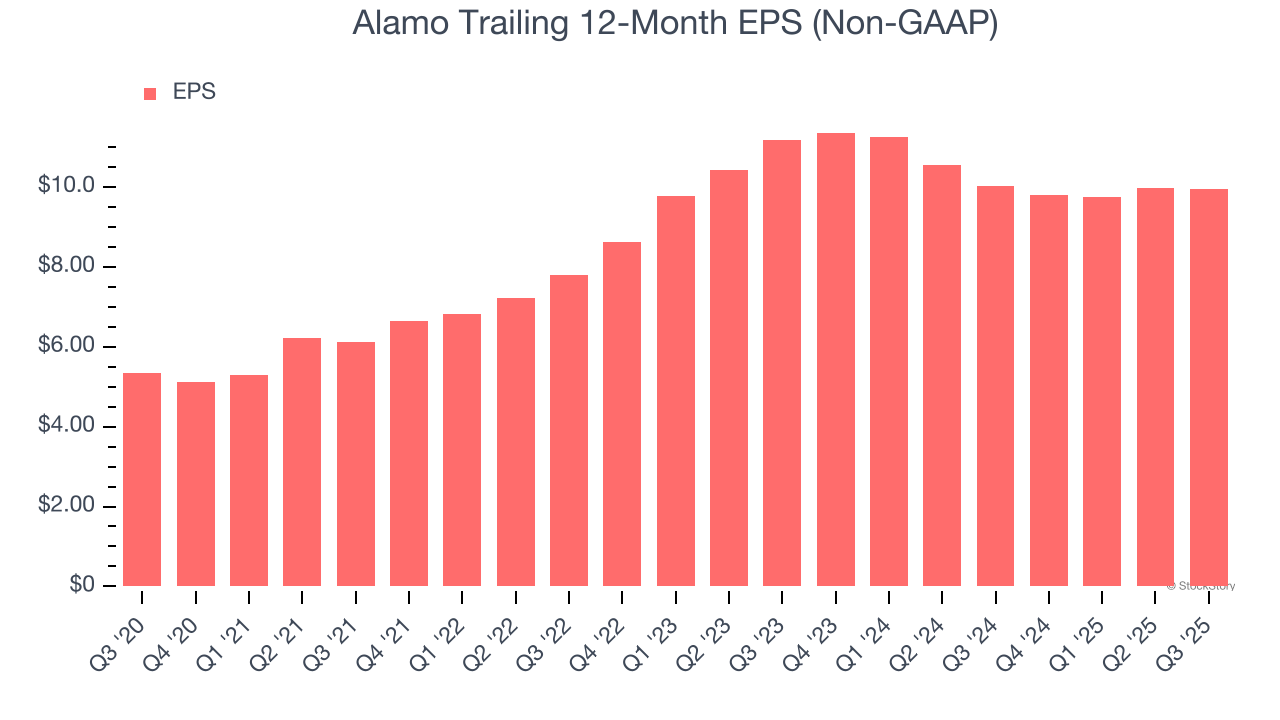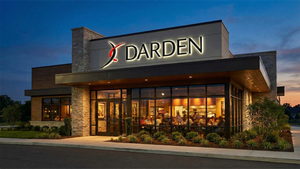
Specialized equipment manufacturer for infrastructure and vegetation management Alamo Group (NYSE: ALG) announced better-than-expected revenue in Q3 CY2025, with sales up 4.7% year on year to $420 million. Its non-GAAP profit of $2.34 per share was 11.3% below analysts’ consensus estimates.
Is now the time to buy Alamo? Find out by accessing our full research report, it’s free for active Edge members.
Alamo (ALG) Q3 CY2025 Highlights:
- Revenue: $420 million vs analyst estimates of $407.6 million (4.7% year-on-year growth, 3.1% beat)
- Adjusted EPS: $2.34 vs analyst expectations of $2.64 (11.3% miss)
- Adjusted EBITDA: $55.01 million vs analyst estimates of $58.77 million (13.1% margin, 6.4% miss)
- Operating Margin: 8.9%, down from 10% in the same quarter last year
- Market Capitalization: $2.15 billion
Robert Hureau, Alamo Group's President and Chief Executive Officer commented, "The Company's third quarter results were mixed. The Industrial Equipment Division continued to perform exceptionally well, delivering strong year-over-year double digit net sales growth for the seventh consecutive quarter. While Industrial Equipment orders fluctuate from quarter to quarter, year-to-date bookings in the division reflect modest growth and backlog levels remain healthy. In contrast, the Vegetation Management Division continued to experience softness in its end markets, however, bookings in the division slightly improved. Operationally, in the Vegetation Management Division we have consolidated facilities in an effort to reduce fixed costs and improve manufacturing throughput and materials management. To date, we have realized the fixed cost savings. While productivity improvements are tracking more slowly than anticipated, we are advancing our operational initiatives and expect further benefits in the coming quarters."
Company Overview
Expanding its markets through acquisitions since its founding, Alamo (NSYE:ALG) designs, manufactures, and services vegetation management and infrastructure maintenance equipment for governmental, industrial, and agricultural use.
Revenue Growth
A company’s long-term performance is an indicator of its overall quality. Any business can experience short-term success, but top-performing ones enjoy sustained growth for years. Over the last five years, Alamo grew its sales at a mediocre 6.6% compounded annual growth rate. This fell short of our benchmark for the industrials sector and is a rough starting point for our analysis.

We at StockStory place the most emphasis on long-term growth, but within industrials, a half-decade historical view may miss cycles, industry trends, or a company capitalizing on catalysts such as a new contract win or a successful product line. Alamo’s performance shows it grew in the past but relinquished its gains over the last two years, as its revenue fell by 1.3% annually. Alamo isn’t alone in its struggles as the Agricultural Machinery industry experienced a cyclical downturn, with many similar businesses observing lower sales at this time. 
This quarter, Alamo reported modest year-on-year revenue growth of 4.7% but beat Wall Street’s estimates by 3.1%.
Looking ahead, sell-side analysts expect revenue to grow 5.3% over the next 12 months. While this projection indicates its newer products and services will catalyze better top-line performance, it is still below average for the sector.
Software is eating the world and there is virtually no industry left that has been untouched by it. That drives increasing demand for tools helping software developers do their jobs, whether it be monitoring critical cloud infrastructure, integrating audio and video functionality, or ensuring smooth content streaming. Click here to access a free report on our 3 favorite stocks to play this generational megatrend.
Operating Margin
Operating margin is a key measure of profitability. Think of it as net income - the bottom line - excluding the impact of taxes and interest on debt, which are less connected to business fundamentals.
Alamo has managed its cost base well over the last five years. It demonstrated solid profitability for an industrials business, producing an average operating margin of 10.1%. This result was particularly impressive because of its low gross margin, which is mostly a factor of what it sells and takes huge shifts to move meaningfully. Companies have more control over their operating margins, and it’s a show of well-managed operations if they’re high when gross margins are low.
Looking at the trend in its profitability, Alamo’s operating margin rose by 1.7 percentage points over the last five years, as its sales growth gave it operating leverage.

This quarter, Alamo generated an operating margin profit margin of 8.9%, down 1 percentage points year on year. Since Alamo’s operating margin decreased more than its gross margin, we can assume it was less efficient because expenses such as marketing, R&D, and administrative overhead increased.
Earnings Per Share
Revenue trends explain a company’s historical growth, but the long-term change in earnings per share (EPS) points to the profitability of that growth – for example, a company could inflate its sales through excessive spending on advertising and promotions.
Alamo’s EPS grew at a remarkable 13.2% compounded annual growth rate over the last five years, higher than its 6.6% annualized revenue growth. This tells us the company became more profitable on a per-share basis as it expanded.

Diving into Alamo’s quality of earnings can give us a better understanding of its performance. As we mentioned earlier, Alamo’s operating margin declined this quarter but expanded by 1.7 percentage points over the last five years. This was the most relevant factor (aside from the revenue impact) behind its higher earnings; interest expenses and taxes can also affect EPS but don’t tell us as much about a company’s fundamentals.
Like with revenue, we analyze EPS over a shorter period to see if we are missing a change in the business.
For Alamo, its two-year annual EPS declines of 5.7% mark a reversal from its (seemingly) healthy five-year trend. We hope Alamo can return to earnings growth in the future.
In Q3, Alamo reported adjusted EPS of $2.34, down from $2.38 in the same quarter last year. This print missed analysts’ estimates, but we care more about long-term adjusted EPS growth than short-term movements. Over the next 12 months, Wall Street expects Alamo’s full-year EPS of $9.94 to grow 20.5%.
Key Takeaways from Alamo’s Q3 Results
We enjoyed seeing Alamo beat analysts’ revenue expectations this quarter. On the other hand, its EBITDA missed and its EPS fell short of Wall Street’s estimates. Overall, this was a weaker quarter. The stock traded down 2.7% to $168.28 immediately after reporting.
Alamo didn’t show it’s best hand this quarter, but does that create an opportunity to buy the stock right now? When making that decision, it’s important to consider its valuation, business qualities, as well as what has happened in the latest quarter. We cover that in our actionable full research report which you can read here, it’s free for active Edge members.





